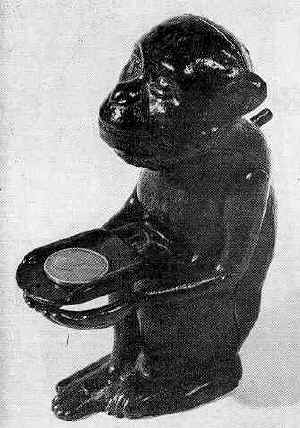Monkey Bank
by F.H. Griffith - HOBBIES Magazine - April, 1958
 A quite rare but unpretentious mechanical bank is our choice as
No. 63 in the numerical classification of the mechanical banks. This bank, the Monkey
Bank, is very possibly an Ives product and this possibility adds somewhat to its
desirability. Other than the Bull Dog Savings Bank, definitely an Ives product and an
outstanding mechanical bank, it is not known conclusively just what other mechanical banks
they did make. The Ives Company was most certainly outstanding in the production of cast
iron toys and any mechanical banks produced by them would naturally have a certain degree
of prestige. This is not meant to imply that other manufacturers of cast iron toys did not
make some outstanding items, but the Ives line as a whole was on a very high level.
Certainly, for example, no one surpassed the J. & E. Stevens Company in the field of
mechanical banks, however, this was one phase in the overall cast iron toy group.
A quite rare but unpretentious mechanical bank is our choice as
No. 63 in the numerical classification of the mechanical banks. This bank, the Monkey
Bank, is very possibly an Ives product and this possibility adds somewhat to its
desirability. Other than the Bull Dog Savings Bank, definitely an Ives product and an
outstanding mechanical bank, it is not known conclusively just what other mechanical banks
they did make. The Ives Company was most certainly outstanding in the production of cast
iron toys and any mechanical banks produced by them would naturally have a certain degree
of prestige. This is not meant to imply that other manufacturers of cast iron toys did not
make some outstanding items, but the Ives line as a whole was on a very high level.
Certainly, for example, no one surpassed the J. & E. Stevens Company in the field of
mechanical banks, however, this was one phase in the overall cast iron toy group.
The Monkey Bank was designed by C.F. Ritchel of Bridgeport, Conn., and patented by him November 7, 1882 under Design Patent No. 13,400. It is interesting to note that on the same date he patented the Shoot That Hat Bank under Design Patent No. 13,401. The writer knows of only one other case where the patentee had consecutive patent numbers on two different mechanical banks. C.F. Bailey was the individual and the date was July 26, 1910. The banks are the Billy Goat Bank, No. 965,842, and the North Pole Bank, No. 965,843. Ives very possibly produced the Monkey Bank but, like Shoot That Hat Bank, it may have been made by either H.L. Judd or the Mechanical Novelty Works. Perhaps at some future date evidence will turn up to prove conclusively the actual manufacturer.
The bank shown was obtained by the writer from the collection of the late Dr. Arthur E. Corby. It is in good condition and as far as the paint goes it is simply an overall brown type of varnish finish. There are no decorative colors of any kind and no highlighting of any parts. As a matter of fact it’s rather interesting in its simplicity.
The operation of the bank is also quite simple. A coin is placed on the flat slide type device held in the hands of the monkey and the lever in back is then pressed. This causes the arms to rise and in turn lifts the so-called tray, and the coin slides into a slot in the monkey’s stomach. It might be well to mention that this bank is at times referred to as the Monkey With Tray. This is a little confusing, however, as there is a tin mechanical bank that does consist of a monkey holding a tray, and it is felt best that this bank be known as the Monkey With Tray. Actually the Monkey Bank under discussion is not holding a tray in his hands and the name Monkey Bank seems sufficient, particularly under the circumstance that no other mechanical bank is known by this name. There is also, of course, the Monkey and Cocoanut Bank, but there certainly seems to be no reason to confuse these three different banks.
While simple in its operation and appearance, the Monkey Bank is a very desirable addition to any mechanical bank collection. It is an elusive item to find, and particularly so in good condition.
